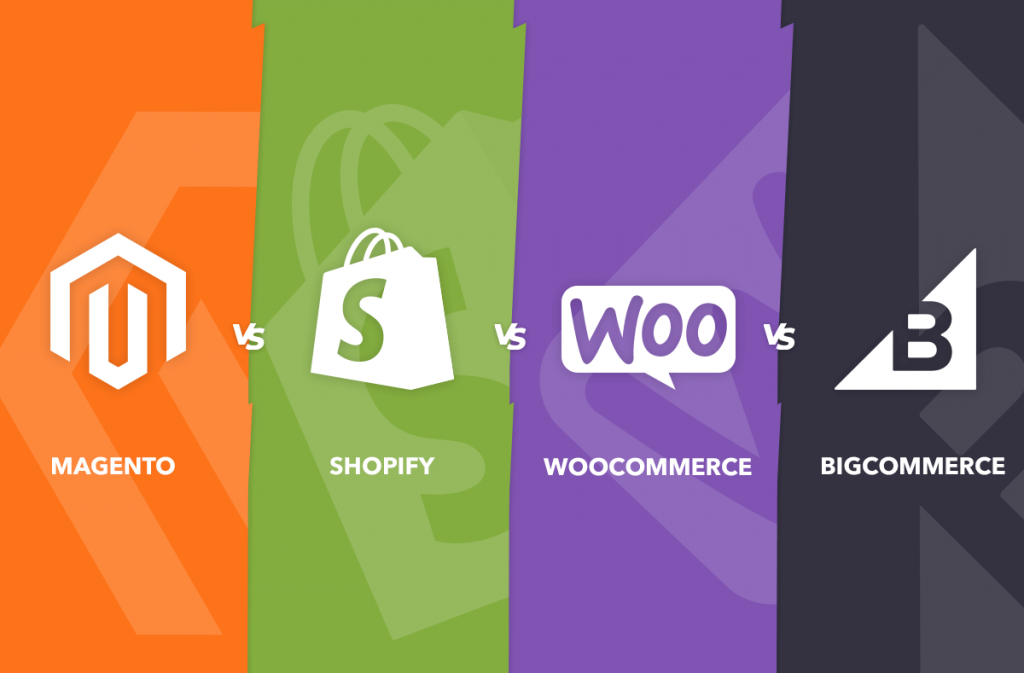To run a successful eCommerce business, you need to choose a good platform. Usually, the choice lies between the most popular marketplaces — Shopify vs BigCommerce vs WooCommerce vs Magento. The choice is becoming even more relevant when you consider competition on all these platforms. Shopify only had more than 2 million online stores as of 2023.
Thus, if you’re thinking about working in the online segment, your shift to one of those marketplaces is inevitable. Let’s take a quick look at every one of them.
1. Shopify

Shopify has been running since 2006. Shopify is one of the leading participants in online retail. It gives entrepreneurs efficient software solutions to launch their online shops. Utilizing Shopify’s tools, businesses can not only launch websites but also promote them and approach both customers and partners.
Payment Methods
Shopify enables entrepreneurs to create their accounts automatically once they launch their stores. This means that there’s no necessity to involve third-party payment providers. On the one hand, it means that some popular and easy-to-use e-wallets aren’t available. On the other hand, you can still use such major payment methods as bank transfers or cash orders without paying extra fees to third parties.
Pros
- Easy to use: A great share of Shopify’s popularity lies in its user-friendliness. It gives users a very seamless user experience thanks to an intuitive interface and navigation. Moreover, many functional features are enabled automatically. In simple words, you don’t need to learn coding to set them up.
- Advanced customization: Shopify stands out from the crowd thanks to its wide assortment of themes and templates. This allows businesses to customize their online stores according to their niches and unique styles.
- Payment fees: The lack of third parties is seen as a disadvantage by many. However, Shopify payment methods cut down transaction fees. In fact, only “Starter” plan owners have to pay a 5% transaction fee.
- App store: With Shopify’s app, you can improve the store’s performance in different areas. You can look for marketing apps, conversion solutions, inventory management programs, and many more.
- Efficient promotion: Shopify provides numerous marketing tools. You can integrate your store with different SEO instruments to boost the store’s visibility and convert traffic into sales.
Cons
- Pricing: Shopify isn’t a budget-friendly option for beginners. There are three monthly plans: Basic ($32), Shopify ($92), and Advanced ($399). The good thing is that you can have a trial period of three months before choosing any tariff.
- No email hosting: Using email marketing, you can keep your customers informed about your products. Unfortunately, Shopify doesn’t give you such a vital function.
- Complicated terminating process: There might be a day when you want to close your online store on Shopify. However, it might seem difficult to terminate your account.
2. Magento

Running since 2008, Magento stands out as one of the most robust eCommerce platforms from the perspective of customization. Magento is constantly improving its functionality. That’s the reason why you should explore more about it.
Payment Methods
Magento payment methods are rather flexible. It offers more than 100 payment modules. Also, unlike Shopify, it enables the use of popular e-wallets. Users can enjoy utilizing Amazon Pay, Apple Pay, Google Pay, and PayPal Checkout. Also, Magento enables integration with 65 payment gateways. However, it doesn’t have the PO function.
Pros
- Scalability: Magento is highly scalable, making it suitable for businesses of all sizes. Whether you're a small startup or an enterprise-level company, Magento can accommodate your growth and evolving eCommerce needs.
- Extensive Customization: The platform offers a high degree of customization, allowing businesses to tailor their online stores to match specific branding and functional requirements. This flexibility ensures a unique and personalized eCommerce experience.
- Robust Feature Set: Magento comes equipped with a comprehensive set of features, including advanced product management, robust SEO capabilities, and versatile payment options. This feature richness provides a solid foundation for creating a feature-packed online store.
- Large Community and Support: Magento boasts a large and active community of developers, users, and experts. This community support ensures that businesses using Magento can tap into a wealth of knowledge, resources, and extensions to enhance their eCommerce capabilities.
- Multi-Store Functionality: Magento supports the creation of multiple online stores from a single backend. This is particularly advantageous for businesses managing various brands or operating in diverse geographic locations, streamlining overall management.
Cons
- Complexity and Learning Curve: Magento's extensive capabilities come with a steeper learning curve. Setting up and customizing the platform may require a higher level of technical expertise.
- Resource Intensive: Magento can be resource-intensive, demanding robust hosting infrastructure to ensure optimal performance. This may translate to higher hosting costs, especially for businesses with large product catalogs and high traffic volumes.
- Cost of Development: While Magento itself is open-source, the cost of development and customization can be higher compared to some other eCommerce platforms. Businesses should budget accordingly for development, especially if intricate customization is necessary for their unique requirements.
3. WooCommerce

Looking for security, customization, support, and powerful analytics? Then, WooCommerce is a good choice. This eCommerce platform has been serving online businesses for more than 12 years. Their expertise might be what your business needs to get to a higher level.
Payment Methods
The capabilities of WooCommerce payment methods are quite similar to Magento’s. The differences are rather minimal. The first one is that WooCommerce doesn’t enable Pay in Store. While offering 60 payment gateways, WooCommerce also adds Facebook Pay.
Pros
- Flexibility: With WooCommerce you can completely control your store’s design. This is possible thanks to an open-source code built on WordPress. This also enables you to fully manage all the functionality of your online store.
- Marketing channels: WooCommerce offers more than 1,000 plugins. Using them, you can promote your products to marketplaces beyond WooCommerce. It gives you more exposure to the target audience.
- Easy to use: WooCommerce open-source code doesn’t cause many difficulties in navigation. Also, it means you don’t have to be a techno-geek. The administration interface is quite simple. If you still can’t figure it out, there are a lot of educational resources here.
- Powerful analytics: WooCommerce enables built-in analytics. You can track the most important statistics, use available instruments to compare them and make effective changes in just several clicks.
Cons
- Need to have experience in WordPress: While being flexible, WooCommerce is a bad choice for those who don’t like WordPress. The plugin doesn’t comply with websites built on other platforms.
- Hidden costs: To remain competitive in other stores, you should use more marketing plugins. This requires additional expenses.
4. BigСommerce

Founded in 2009, BigCommerce is a perfect platform for businesses looking for scalable solutions. It provides eCommerce entrepreneurs with numerous customization tools. Also, it helps you to create a store that will perfectly suit the competition in your specific niche.
Payment Methods
BigCommerce payment methods are somewhat limited compared to its competitors. Payment gateways have to be additionally installed. Plus, there are no such features as Payment on Account, Purchase Order, and Pay in Store.
Pros
- User-Friendly interface: BigCommerce is known for its intuitive and user-friendly interface. It makes it accessible for businesses without extensive technical expertise.
- Scalability: BigCommerce provides scalability for businesses of varying sizes. Whether you're a small startup or an established enterprise, the platform can accommodate your growth without compromising performance.
- Built-in features: The platform comes with a comprehensive set of built-in features, including secure payment gateways, marketing tools, and analytics. This minimizes the need for extensive third-party integrations.
- Responsive Templates: BigCommerce offers a variety of responsive templates that ensure a seamless shopping experience across different devices. These templates are customizable, allowing businesses to align the look and feel of their online stores with their brand identity.
- Multi-Channel Selling: BigCommerce facilitates multi-channel selling by integrating with popular marketplaces like Amazon, eBay, and social media platforms.
Cons
- Transaction fees: While BigCommerce offers various pricing plans, some plans include transaction fees. This can impact the overall cost for businesses, particularly those with higher sales volumes.
- Design limitations: While the platform provides responsive templates, businesses with highly specific design requirements may find some limitations in terms of customization. Extensive design changes may require more advanced coding skills.
- Limited blogging capabilities: BigCommerce's built-in blogging capabilities are not as extensive as dedicated blogging platforms.
Conclusion: Shopify vs Magento vs WooCommerce vs BigCommerce
Every option has its advantages and disadvantages. To make the best choice between BigCommerce vs Shopify vs Magento vs WooCommerce, you need to analyze your business needs, study the market, get familiar with some technical solutions, and consider all the capabilities of the given platforms. Find out which one is better for startups and which is more relevant for big businesses. Explore their growth prospects and stay tuned to updates.



